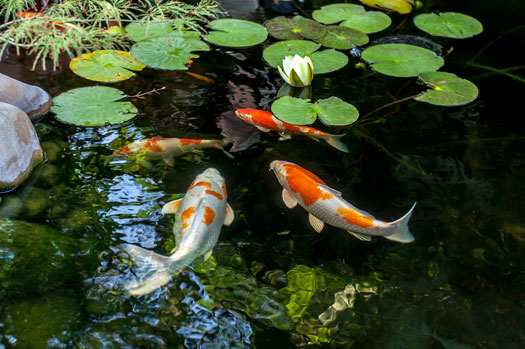- Your shopping cart is empty!
Tips for Preparing a Koi Pond Before Adding Fish

The most difficult aspect of setting up a pond is the structure of the habitat. First you have to consider how much space the pond will take in your property, then you need to create the below-ground space that holds the ecosystem. Other considerations include shade, the aeration system, the biological filtration area, the often overlooked but important surface skimmer, the liner, rocks to provide hiding spaces for your species, and all of the essential pond equipment. All these will need to be in place before filling the pond with water and observing how the structure holds. The next step is to establish the pond so it starts turning into an ecosystem, and this is in preparation to introduce koi and other species.
Nitrogen Cycle for Koi Ponds
Just like with aquariums, fish keepers should always seek to establish and maintain the nitrogen cycle in their ponds. The cycle won’t be completed after koi are introduced, but it should begin when the pond is filled with water, using liquid bacteria like Dry Bacteria from Beaver Creek:
https://www.aquaticwarehouse.com/dry-bacteria-enzyme-treatment-16-oz?search=bacteria&category_id=0
The idea is to start letting the ecosystem develop and become as healthy as possible for koi. The nitrogen cycle is both chemical and biological. You should treat the water before adding bacteria so colonies can form in the tank. The next step would be to add plants, monitor the water with a kit, and introduce a small amount of koi and never goldfish. Koi are much hardier than people think, and this way you won’t be stuck with large, rather ugly feeder goldfish that are known for being carriers of hundreds of diseases and pathogens that will pass on to your koi and are very hard to eradicate.
The Dechlorination Process
Tap water must go through a chlorine removal process before any species, including bacteria and plants, are introduced to the pond. There are several ways you can remove chlorine, but seasoned fish keepers trust in water conditioners over filtration methods because they’ll remove both chlorine and chloramine. Once the water testing kit indicates that chlorine levels are at 0.00 particles per million, bacteria can be added.
How Long to Wait Before Adding Species
After the water has been dechlorinated and bottled bacteria has been added, you should wait 24 hours before adding species. Even though you could introduce koi at this time, it would be better to start out with plants such as hyacinth, lily, and lotus. Give these plants a couple of weeks to oxygenate the water and interact with bacteria before adding koi.
Final Water Check Before Adding Koi
For the most part, koi are hardy fish, but some of the rare variant species are delicate. If you’ve already cycled the pond with plants, invertebrates, and goldfish, conditions should be good for koi. If not, you should measure the water’s pH level, which should be around 7.0-8.1. To be on the safe side, check the chlorine and ammonia levels before releasing koi, and remember to never overfeed them, as this creates an excess of ammonia in a new pond.
When you get your pond up and running and stocked with fish, there are several koi pond supplies you’ll need to acquire to maintain to pond properly. Aquatic Warehouse has everything you need. Take a look at what we have to offer on our website, or give us a call at 858-467-9297 if you have any questions.
